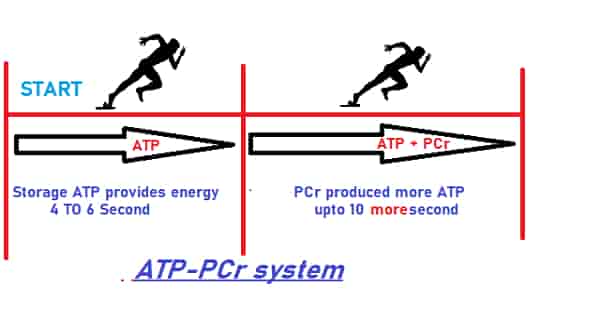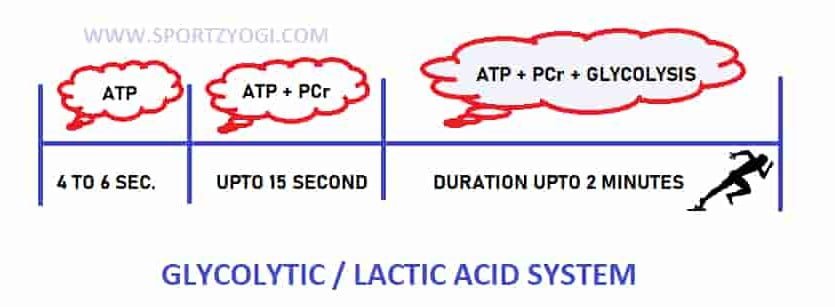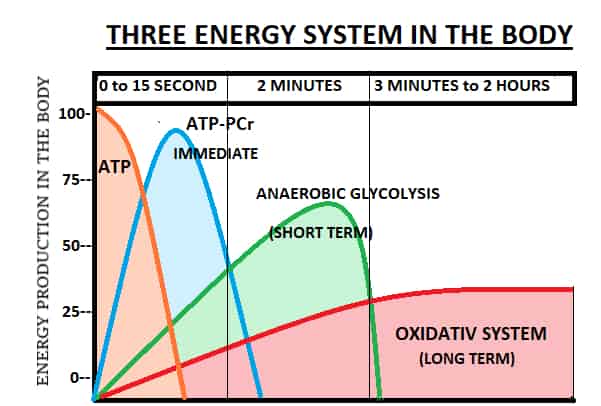what is the Energy system in the body?
The energy system in the body- Energy is needed to produce physical movement, maintain a balanced body temperature, and perform all metabolic activities in the body. Our bodies provide a compound called ADENOSINE TRIPHOSPHATE to perform all bodily activities. ATP is an energy currency of the human body. ATP is stored in the muscle fiber so it is immediately available to produce movement, however, the storage of ATP is limited so any movement that lasts longer than a few seconds requires more ATP to be produced.
The demand for energy is different in every sport according to its condition. In situations of high-intensity activity, the energy supply to the body must be very rapid and in some situations, energy must be supplied over a long period of time.
what are the three energy systems in the body?
Generally, our body has three energy systems that produce ATP energy for any Physical movement or activity.
- ATP-PCr / PHOSPHOGEN system [Anaerobic Alactic]
- GLYCOLYTIC / LACTIC ACID system [Anaerobic lactic]
- OXIDATIVE system [Aerobic]
What are the two classification of energy system based on oxygen supply?
The ATP-PCr and GLYCOLYTIC/ LACTIC ACID SYSTEM is an ANAEROBIC SYSTEM that does not require OXYGEN to produce ATP. The ATP-pc system and anaerobic glycolysis are called ANAEROBIC METABOLISM. It means the synthesis of ATP through a chemical reaction that does not require the presence of oxygen.
The OXIDATIVE SYSTEM is an Aerobic system that requires oxygen to produce ATP.
The Energy system in sports
Energy system in sports plays important role to perform any physical activity weather its immediate, short term or long term.
ATP-PCr SYSTEM/ PHOSPHOGEN SYSTEM
ATP-PCr system or phosphagen system is based on physical movement which is lasting about 5 to 15 seconds. ATP- PC is present in a very small amount in the muscle cells. This system supplies energy for the movement very quickly because this system consists of two sub-systems ATP-CP or Phosphagen Cycle. This system works mainly in explosive types of sports or movements such as STRENGTH POWER movements like throwing, sprinting, or jumping. These types of quick burst movements can be done with the ATP stored in the muscles. During short sustained power movement or any quick burst movement such as a 100-meter sprint, ATP will provide the energy alone for the first few seconds, with a compound called PC [phosphate creatine] buffering the ATP for another second. Like ATP, the amount of PC is limited, so this system can provide energy for movement up to about 15 seconds in total. This system produced ATP very quickly, but not over a long duration. The recovery time of this system is about 3 minutes.


PC [phosphogen system] like ATP is stored in the muscle cells. ATP and PC contain phosphate groups that are collectively referred to as the ‘phosphagen system’.
CHEMICAL REACTION IN ATP-PCr system – When the phosphate molecule of ATP is breakdown in the muscle cell, it generates energy for physical movement, when this action occurs; ATP turns into ADP, this energy system works for about 4 seconds. CP [creatine phosphate] is also present in the muscles, which works after the end of ATP, when CP is broken down, P is separated and goes back to ADP and re-synthesizes ADP into ATP, due to which energy remains constant. This system provides energy for very approximately 10 seconds.
Due to the breakdown of PC into pi and C, an energy release occurs that energy is used to synthesize ATP from ADP and Pi. Hence no need for oxygen for this synthesis of ATP. So, this energy system is very much essential in the event that required a few seconds to complete for example- sprinting in a hundred meter Run, the enzymes that catalyze [speed] the breakdown of PC with the result and formation of ATP is creatine kinase.
PC + ADP= ATP + C
The only means by which PC can be formed from pi and C is the energy released by the breakdown of ATP. This occurs during recovery from exercise.
GLYCOLYTIC System / LACTIC ACID system [anaerobic lactic]
After the ATP-PC system, the energy demands shifted to glycolysis or the lactic acid system. The glycolytic system is based on short-term physical movement which is up to 2 minutes. This system relies on the rapid breakdown of carbohydrates [glucose]. In this anaerobic system, ATP is recently resynthesized with the muscle by the incomplete breakdown of Co2 [sugar] to lactic acid that is why it is known as the lactic acid system in the body. In the body, CO2 is converted to the simple sugar glucose, which is stored in blood as glucose, and in the liver and the muscle as glycogen [cluster of glucose molecules], approximately 300 to 350 of glycogen are stored in the human body. Glycogen is chemically broken down into lactic acid by a series of chemical[CHEMICAL COMPOSITION OF THE BODY] reactions enhance by enzymes called phosphofructokinase hexokinase, pyruvate kinase, and lactic dehydrogenase. During aerobic glycolysis, only three moles of ATP can be resynthesized from one mole of glycogen.


Glycolysis means splitting of glucose to lactic acid or glycogenolysis means splitting of glycogen to glucose.
Anaerobic glycolysis is very important to us during exercise primarily because it provides a relatively rapid supply of ATP exercise that can be performed at a maximum rate of 1 to 3 minutes [800-meter run] depend heavily on the phosphagen system and anaerobic glycolysis for ATP formation.
LACTIC ACID FORMATION IN GLYCOLYTIC SYSTEM –This system produces a by-product called lactate at the time of energy supply, due to which the accumulation of hydrogen ions in the muscles causes it to become acidic, which causes fatigue and burning sensation in the muscles. This energy system produced ATP very quickly but again not over a long duration.
Example- repeated high-intensity movement completely without rest like fast passages of play in BASKETBALL.
OXIDATIVE SYSTEM / AEROBIC SYSTEM
The oxidative system is a long-term energy system; this system is based on physical movement which is more than 2 to 3 minutes and that can be up to 2 to 3 hours. It produces the most energy compared to the other two systems, although it generates energy at a very slow rate, so it cannot meet the demand of intense exercise. This energy system can produce ATP only with the help of oxygen. The aerobic system uses oxygen to break down glucose and fat to produce ATP for muscular contraction. All aerobic metabolisms occur in the mitochondria of the muscle cell.
So the question is how aerobic energy system work in our body?
In this process, in the presence of oxygen 1 mole of glycogen is completely broken to co2 and h2o releasing sufficient energy to resign the size of 38 moles of ATP. It involves with highly complex chemical reaction enhanced by enzymes called acetyl coenzyme, phosphorylase, hexokinase, and phosphofructokinase.
The reaction of the aerobic system can be divided into 3 main series, the total energy produced in this system is 38 ATP:-
AEROBIC GLYCOLYSIS [2 ATP]
KREBS CYCLE [2 ATP]
ELECTRON TRANSPORT SYSTEM [34 ATP]
AEROBIC GLYCOLYSIS
The first series of reactions involved in the aerobic breakdown of glycogen to CO2 and H2o is glycolysis. The presence of oxygen inhibits the accumulation of lactic acid during the reaction. 1 Mol of glycogen is broken down into two moles of pyruvic acid releasing through energy for resynthesizing 3 moles of ATP with the help of energy called NAD [Nicotinnaid, adenine, dinucleobdo].
C6H12O6 ⇒ 2C3 Hu O3 energy
Energy + 3 ADP + 3pi ⇒ 3 ATP
GLUCOGEN[glycogenlysis] ⇒ GLUCOSE [ADP + Pi] ⇒ ATP
PYRUVIC ACID[sufficient O2]
CO2 H2O ⇒ ATP
THE KREB CYCLE
It is named after its discovery sir Hans Kreb. The Pyruvic acid formed during aerobic glycolysis passes into the mitochondria. It is broken down into a series of reactions called the Krebs cycle. In the Krebs cycle, three stages of reaction occur.
- CO2 produced
- Oxidation
- ATP produced
In the Krebs cycle, the produced CO2 is removed from pyruvic acid and forms acetyl 1 co-enzymes, A, combining with co-enzyme, A, all the produced CO2 diffuses into the blood and is carried to the lungs where it is eliminated from the body through respiration.
This production of Co2 is because of the oxidation of pyruvic acid i.e. when H is removed by oxidation it removes the hydrogen ion CO2 is formed. In the Krebs cycle mole of ATP are formed.
ELECTRON TRANSPORT SYSTEM
In this system, H2O is formed from the hydrogen ions and electrons that are removed in the Krebs cycle and the o2 we breathe. This is otherwise called the respiratory chain. here major chemical events take place the hydrogen ions and electrons are transported by electrons Carriers to the o2 we breathe to form water through a series of enzymatic reactions, at the same time ATP is resynthesized in coupled reaction from the energy release total of 39 moles of ATP are resynthesized.
(C6H12)O6) + 6O2 + ENERGY
ENERGY + 38 ATP + 38Pi ⇒ 39 ATP
4H + 4e + O2 ⇒ 2H2O ENERGY
The energy released from the breakdown of foodstuff and phosphocreatine is functionally linked or coupled to the energy needs of resynthesizing ATP from ADP pi. It is a fundamental principle involved in the metabolic production of ATP.





